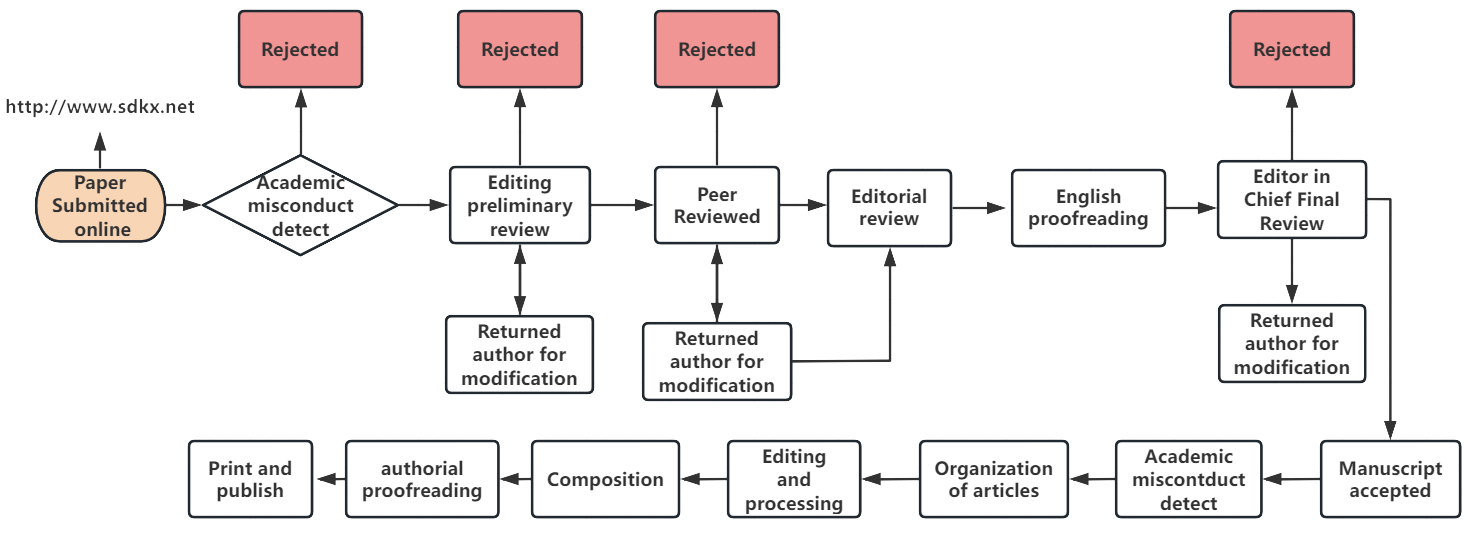
Paper submitted: The manuscript has been entered into the system; the manuscript number will be sent to you by email.
Prereview by editors: Editors will conduct a formal review to determine whether the manuscript aligns with the aims and scope of the journal and meets academic writing standards. During this stage, all manuscripts undergo academic misconduct detection, including plagiarism, duplication, and multiple submissions. If any misconduct is detected, the manuscript will be unconditionally rejected. If the manuscript passes the review, it will proceed to the preliminary review stage; if rejected, please check the review comments in the notification email.
Revision after preliminary review: If problems are found during the preliminary review, the author will be notified via the system and email to make revisions. The author should revise and improve the manuscript according to the preliminary review comments and submit a detailed point-by-point response when returning the revised version.
External review: The journal adopts a single-blind peer review system, meaning that the authors do not know the reviewers’ identities, while the reviewers can access the authors’ information. The journal’s online submission system ensures that authors cannot see reviewer information. Each manuscript is sent to two external reviewers to evaluate its novelty, scientific merit, and publication value; if their opinions differ, it will be sent to a third reviewer for further evaluation.
Revision: The author should revise and improve the manuscript according to the review comments and submit a detailed point-by-point response when returning the revised version.
Rejection: If the experts consider the manuscript unsuitable for publication, it will be rejected.
Re-review: If the experts request that the manuscript needs to be revised and reviewed, it will undergo this process.
Final review: The editor-in-chief makes the final decision on whether the article can be published and is responsible for the overall content of the journal.
Editorial processing: The responsible editor checks the paper’s text, figures, and references, etc., and standardizes them according to the requirements of the editorial office.
Awaiting publication: After peer review, author revision, and editorial processing, manuscripts deemed suitable for publication enter the awaiting publication stage.
Layout and issue planning: The responsible editor selects manuscripts and issues according to the column requirements and layout. Authors whose papers are scheduled for publication will be notified by email or phone.
Revision after layout: Revise the manuscript according to the layout editor’s requirements.
Proofreading: After typesetting, there may be typesetting or language errors in the manuscript, which require joint proofreading by the author, editor, and proofreader.
Publication: After proofreading confirms no errors, the paper is printed and published.
Supplements, Special Issues, and Special Columns: The above review process also applies to submissions for supplements, special issues, and special columns. Manuscripts submitted for supplements, special issues, or special columns will undergo the same review and editorial process as regular submissions, and the final decision on acceptance will be made by the editors-in-chief. The editor-in-chief is responsible for the entire content of the journal, including supplements, special issues, and special columns. When organizing supplements or special issues, the editorial office may invite authoritative experts in the field to serve as guest editors. The responsibilities of guest editors include proposing themes, soliciting manuscripts, organizing peer reviews, and addressing any issues that arise during the publication process. The work of guest editors will be supervised by the editor-in-chief to ensure the fairness of the manuscript review process.
Submission by Editorial Board Members / Editors / Guest Editors: Manuscripts submitted by editorial board members, editors, or guest editors must follow the same peer review and editorial procedures as all other submissions. Editorial board members, editors, and guest editors shall not participate in the review, editing, or acceptance decisions of papers authored by themselves, their family members, or colleagues. Peer review must be conducted independently of the authors, editors, and their research groups involved.